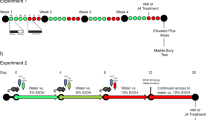Abstract
The effect of the methylxanthines caffeine, theophylline and isobutylmethylxanthine (IBMX) on ethanol-induced ataxia and loss of righting reflex was investigated in three strains of mice. A significant potentiation of ethanol-induced ataxia was produced in all strains of mice at 20, 45 and 75 min after ethanol in mice pretreated with 62.5 mg/kg caffeine and 12.5 mg/kg IBMX. In mice pretreated with 40 mg/kg caffeine potentiation of ethanol-induced ataxia was observed only at 20 min after ethanol. Theophylline pretreatment produced no alteration in ethanol-induced ataxia. The results of methylxanthine pretreatment on ethanol-induced ataxia were similar, regardless of a shorter (10 min) or longer (75 min) pretreatment time. The methylxanthines produced no effect on motor coordination or behavior when administered separately. Although ethanol-induced loss of righting reflex was shortened by theophylline, neither caffeine nor IBMX altered the duration of loss of righting reflex. It is possible that inhibition of adenosine uptake, a known effect of the methylxanthines, may be a more likely explanation for the modulation of the behavioral effects of ethanol.
Similar content being viewed by others
References
Barraco RA, Coffin VL, Altman HJ, Phillis JW (1983) Central effects of adenosine analogues on locomotor activity in mice and antagonism of caffeine. Brain Res 272:392–395
Bruns RF, Daly JW, Snyder SH (1983) Adenosine receptor binding: structure-activity analysis generates extremely potent xanthine antagonists. Proc Natl Acad Sci USA 80:2077–2080
Burnstock G, Brown CM (1981) An introduction to purinergic receptors. In: Burnstock G (ed) Purinergic receptors. Chapman and Hall, London New York, pp 1–45
Coffin VL, Taylor JA, Phillis JW, Altman HJ, Barraco RA (1984) Behavioral interaction of adenosine and methylxanthines on central purinergic systems. Neurosci Lett 47:91–98
Daly JW, Bruns RF, Snyder SH (1981) Adenosine receptors in the central nervous system. Relationship to the central action of methylxanthines. Life Sci 28:2083–2097
Dar MS, Mustafa SJ, Wooles WR (1983) Possible role of adenosine in the CNS effects of ethanol. Life Sci 33:1363–1374
Dunham NW, Miya TS (1957) A note on a simple apparatus for detecting neurological deficit in rats and mice. J Am Pharm Assoc 4:208–209
Dunwiddie TV, Hoffer BJ, Fredholm BB (1981) Alkylxanthines elevate hippocampal excitability. Evidence for a role of endogeneous adenosine. Naunyn-Schmiedeberg's Arch Pharmacol 316:326–330
Dunwiddie TV, Worth T (1982) Sedative and anticonvulsant effects of adenosine analogs in mouse and rat. J Pharmacol Exp Ther 220:70–76
Gallaher EJ, Parson LM, Goldstein DB (1982) The rapid onset of tolerance to ataxia effects of ethanol in mice. Psychopharmacology 78:67–70
Goldstein DB (1983) Pharmacology of alcohol. In: Goldstein DB (ed) Genetics. Oxford University Press, New York Oxford, pp 120–140
Kakihana R, Brown DR, McClearn GE, Tabershaw IR (1966) Brain sensitivity to alcohol in inbred mouse strains. Science 154:1574–1575
Katims JJ, Annau Z, Snyder SH (1983) Interactions in the behavioral effects of methylxanthines and adenosine derivatives. J Pharmacol Exp Ther 227:167–173
Londos, C, Cooper DMF, Wolff J (1980) Subclasses of external adenosine receptors. Proc Natl Acad Sci USA 77:2251–2254
McClearn GE, Rogers DA (1959) Differences in alcohol preference among inbred strains of mice. Q J Stud Alc 20:691–695
Molinengo L (1964) Azione di alcuni depressivi del SNC sulla coordinazione motoria del ratto. Arch Ital Sci Farmacol 14:288–291
Phillis JW, Edstrom JP, Kostopoulos GK, Kirkpatrick JR (1979) Effects of adenosine nucleotides on synaptic transmission in the cerebral cortex. Can J Physiol Pharmacol 57:1289–1312
Phillis JW, Wu PH (1982) The effect of various centrally active drugs on adenosine uptake by the central nervous system. Comp Biochem Physiol 72C:179–187
Proctor R, Dunwiddie TV (1984) Behavioral sensitivity to purinergic drugs parallels ethanol sensitivity in selectively bred mice. Science 224:519–521
Rall TW (1982) Evolution of the mechanism of action of methylxanthines: from calcium mobilizers to antagonists of adenosine receptors. Pharmacologist 24:277–287
Remmer H, Siegert M, Nitze HR, Kirsten I (1962) Die Gewöhnung an langwirkende Barbiturate. Naunyn Schmiedebergs Arch Exp Pathol Pharmakol 243:468–478
Sattin A, Rall TW (1970) The effect of adenosine and adenine nucleotides on the adenosine 3′–5′-phosphate content of guinea pig cerebral cortex slices. Mol Pharmacol 6:13–23
Snyder SH, Katims JJ, Annau Z, Bruns RF, Daly JW (1981) Adenosine receptors and behavioral actions of methylxanthines. Proc Natl Acad Sci USA 78:3260–3264
Van Calker D, Muller M, Hamprecht B (1979) Adenosine regulates via two different types of receptors the accumulation of cyclic AMP in cultured brain cells. J Neurochem 33:999–1005
Wachtel H (1983) Species differences in behavioral effects of rolipram and other adenosine cyclic 3′, 5′,-monophosphate phosphodiesterase inhibitors. J Neural Transm 56:139–152
Wilson EC (1967) Ethanol metabolism in mice with different levels of hepatic alcohol dehydrogenase. In: Maickel RP (ed) Biochemical factors in alcoholism. Pergamon New York, pp 115–124
Yarbrough GG, McGuffin-Clineschmidt JC (1981) In vivo behavioral assessment of central nervous system purinergic receptors. Eur J Pharmacol 76:137–144
Author information
Authors and Affiliations
Rights and permissions
About this article
Cite this article
Dar, M.S., Jones, M., Close, G. et al. Behavioral interactions of ethanol and methylxanthines. Psychopharmacologia 91, 1–4 (1987). https://doi.org/10.1007/BF00690916
Received:
Revised:
Issue Date:
DOI: https://doi.org/10.1007/BF00690916



